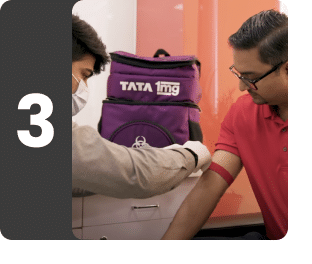HE4 With ROMA Index
Understanding HE4 With ROMA Index
What is HE4 With ROMA Index?
The HE4 With ROMA Index is a diagnostic test to assess the risk of epithelial ovarian cancer in women. It measures the level of Human Epididymis Protein 4 (HE4) and CA 125 in combination with the Risk of Ovarian Malignancy Algorithm (ROMA) index, providing valuable information for the early detection and management of ovarian cancer.
Ovarian cancer is one of the most common gynecological cancers in women. Early detection of ovarian cancer can be challenging due to its non-specific symptoms often mistaken for other conditions. This highlights the importance of early detection and advanced diagnostic tests like the HE4 With ROMA Index test.
The HE4 With ROMA Index test is not intended as a screening or standalone diagnostic test. It should be used in combination with other diagnostic tools like imaging, biopsies, etc., as well as clinical evaluation for confirmatory diagnosis of ovarian cancer. This test combines the measurement of HE4, a protein that is produced by cells in the ovaries and the lining of the respiratory tract, often elevated in epithelial ovarian cancer, and CA 125, a protein that can be elevated in ovarian cancer and other physiological or pathological conditions such as menstruation, pregnancy, endometriosis, uterine fibroids, and pelvic inflammatory disease.
The ROMA index is a mathematical formula that combines the levels of HE4 and CA 125 with menopausal status (defined as the absence of periods for 12 months in a row) to estimate ovarian cancer risk, categorizing women with an adnexal mass into high-risk or low-risk groups, and enhances accuracy in early detection. ROMA is not a definitive indicator of cancer presence or absence and is not intended for general cancer screening. However, a low-risk ROMA result should not rule out an oncologist (a doctor who specializes in diagnosing and treating cancer) referral if the initial cancer risk is high. Additionally, ROMA has not been validated for patients previously treated for cancer, undergoing chemotherapy, or below 18 years of age.
The HE4 With ROMA Index test is specifically recommended for women above 18 years of age having adnexal masses planned for surgery and who have not yet been referred to an oncologist. This test is not suitable for monitoring mucinous or germ-cell ovarian cancer. It offers a more nuanced assessment of ovarian cancer risk, particularly distinguishing between malignant (cancerous) and benign (non-cancerous) ovarian masses.
No special preparation is required for this test. However, a brief clinical history or doctor's prescription should be provided during sample collection. Additionally, indicate the date of your last menstrual period (LMP) or menopausal status. Inform your doctor about any medications or supplements you may be taking, as these could impact the test results.
Don't self-medicate at home solely based on the test results, and always consult a doctor for a proper understanding of your health needs.
Please note: This is an outsourced test. The sample for this test is collected by TATA 1MG and processed at a NABL accredited partnered lab.
What is HE4 With ROMA Index used for?
The HE4 With ROMA Index test is done:
- To assess the risk of epithelial ovarian cancer in women with an adnexal or pelvic mass.
- To help in the early detection of epithelial ovarian cancer in women with a pelvic mass or cyst.
- To distinguish between malignant (cancerous) or benign (non-cancerous) ovarian masses.
- As part of ovarian cancer screening for women at high risk due to a family history of ovarian or breast cancer.
- To monitor the effectiveness of epithelial ovarian cancer treatment.
- To monitor the disease progression or recurrence of epithelial ovarian cancer.
What does HE4 With ROMA Index measure?
Contains 3 testsThe HE4 With ROMA Index test measures key biomarkers to assess the risk of epithelial ovarian cancer. It includes Human Epididymis Protein 4 (HE4), CA 125, and the Risk of Ovarian Malignancy Algorithm (ROMA) index evaluation. In cases of ovarian cancer, the levels of HE4 and CA 125 are often elevated. The ROMA index combines HE4 levels with CA 125 along with other factors like the woman’s age and menopausal status for the calculation of a numerical score. This combination of biomarkers and clinical history enhances the accuracy of the HE4 With ROMA Index test in predicting the presence of epithelial ovarian cancer, particularly in its early stages. This test is instrumental in women with pelvic masses who have not yet undergone surgery.
What sets the HE4 With ROMA Index test apart is its ability to provide a nuanced assessment of epithelial ovarian cancer risk. While CA 125 alone can sometimes yield false positive results due to its elevation in other conditions like endometriosis, HE4 offers added specificity and precision. Moreover, the ROMA index considers factors like age and menopausal status, further refining the risk assessment. This comprehensive approach not only helps in the early detection of epithelial ovarian cancer but also helps differentiate between malignant (cancerous) and benign (non-cancerous) ovarian masses, guiding doctors in making informed decisions regarding further diagnostic workup and determining whether a woman with a pelvic mass is at high or low risk for ovarian cancer before surgery, which can guide treatment decisions and help in planning surgery.
HE4 - Human Epididymis Protein 4
ROMA Value

CA125 (Cancer Antigen 125)
CA125 is a protein found in most ovarian cancer cells and some normal tissues. A CA125 (Cancer Antigen 125) test is commonly advised to detect ovarian cancer by measuring the amount of CA125 protein in the blood. A deranged level of CA125 antigen may indicate the presence of certain cancers, primarily ovarian cancer or other non-cancerous conditions, including endometriosis, pelvic inflammatory disease, ovarian cysts, etc.
Know more about CA125 (Cancer Antigen 125)
Answers to Patient Concerns & Frequently Asked Questions (FAQs) about HE4 With ROMA Index
Frequently Asked Questions about HE4 With ROMA Index
Q. What is the HE4 With ROMA Index test for?
Q. Who should undergo the HE4 With ROMA Index test?
Q. How is the HE4 With ROMA Index test performed?
Q. Can the HE4 With ROMA Index test be used to monitor treatment?
Q. How is the HE4 test different from the CA 125 test?
Q. What do the HE4 With ROMA Index test results mean?
Q. What should I do if my test results are abnormal?
Q. Who is at higher risk of ovarian cancer?
Q. What are the symptoms associated with ovarian cancer?
Q. How can I reduce the risk of ovarian cancer?
Book a HE4 With ROMA Index test at home near me





Other tests









